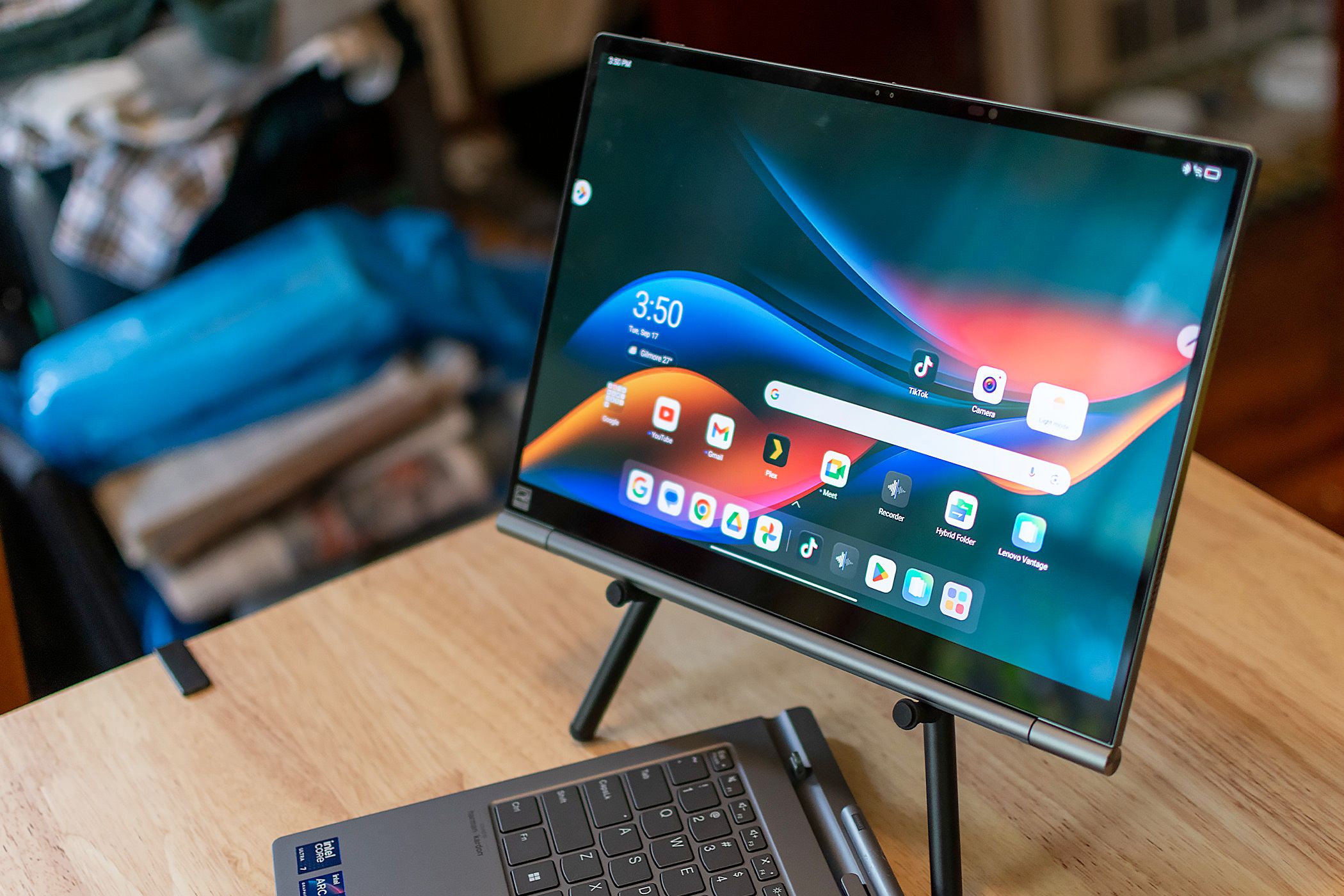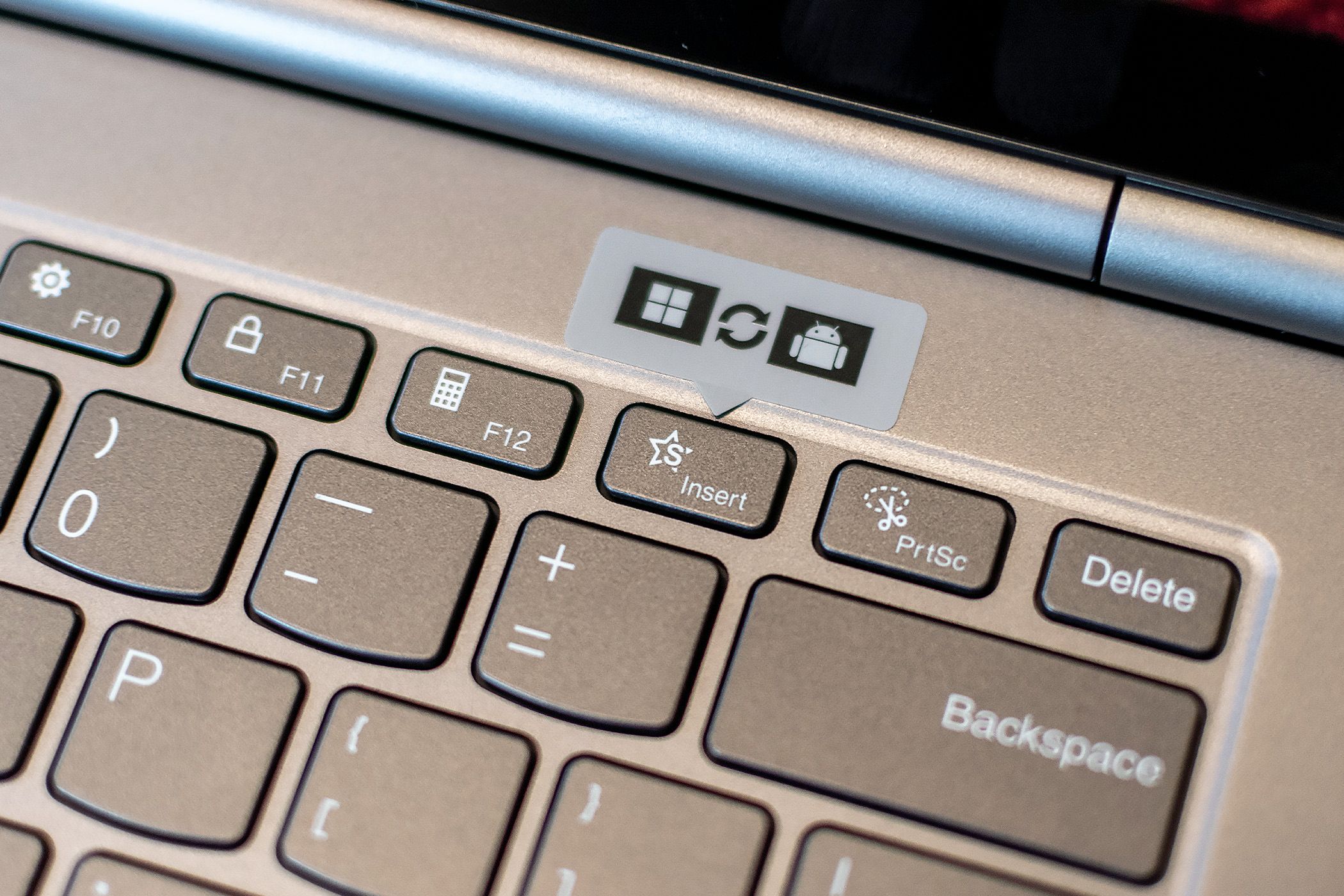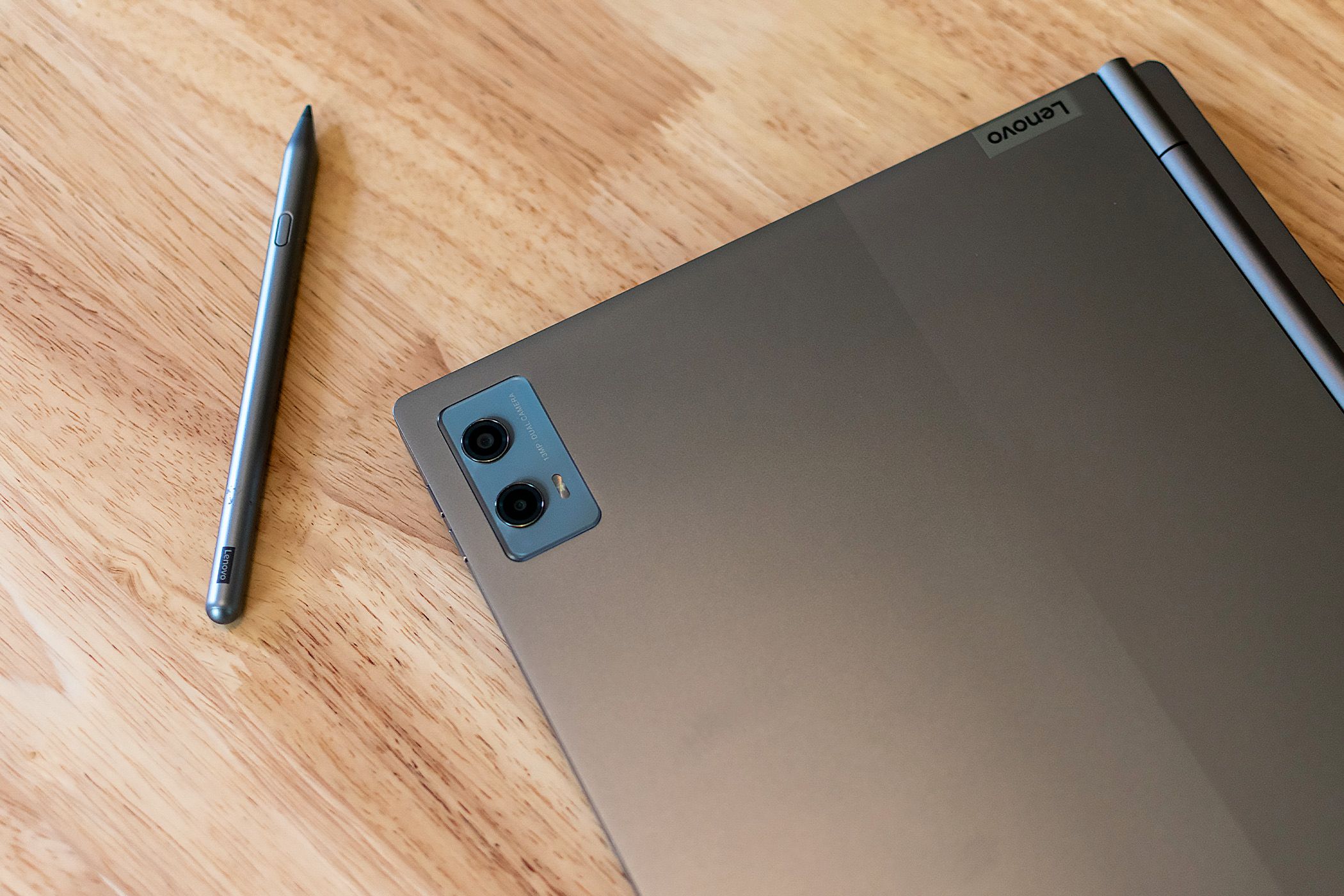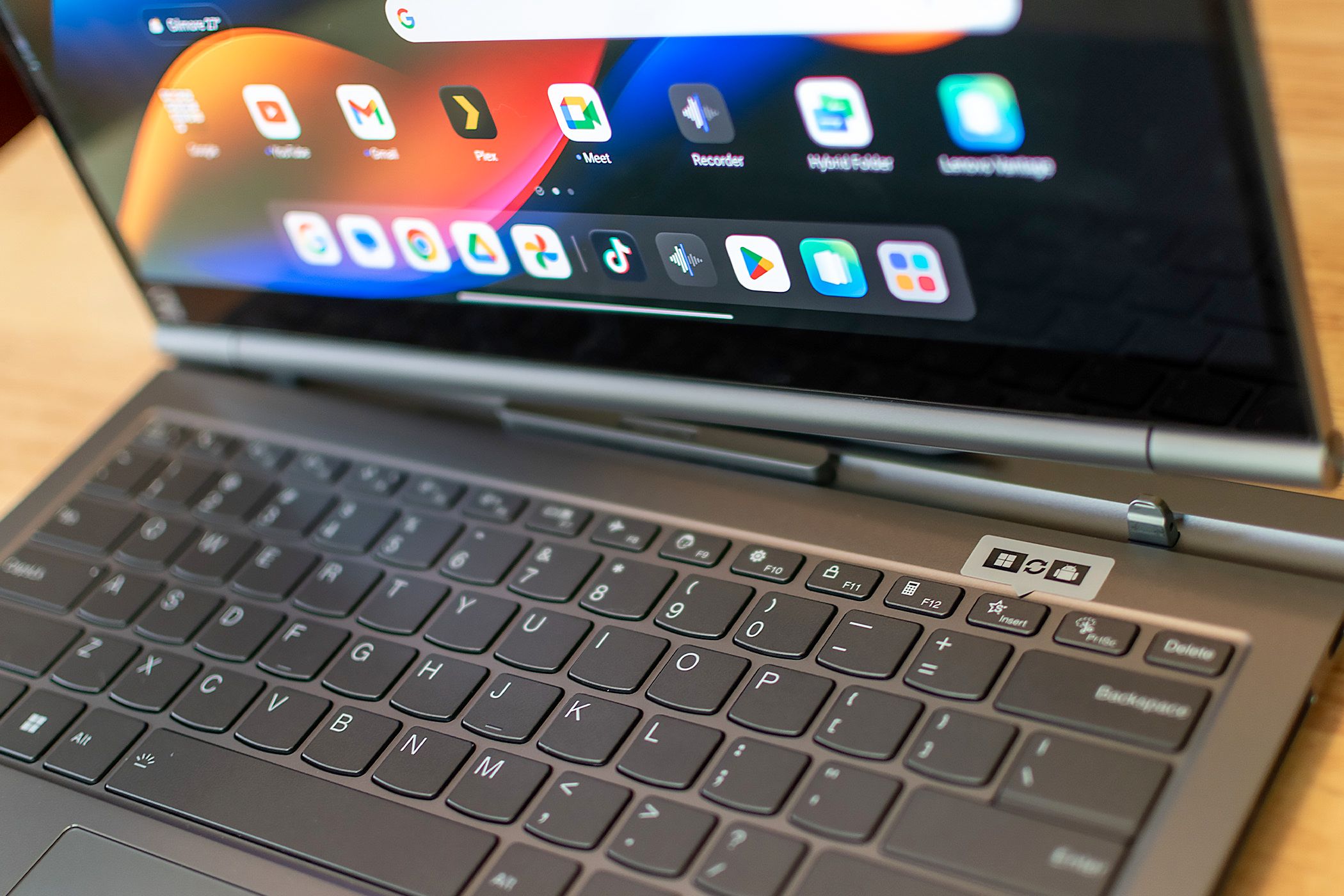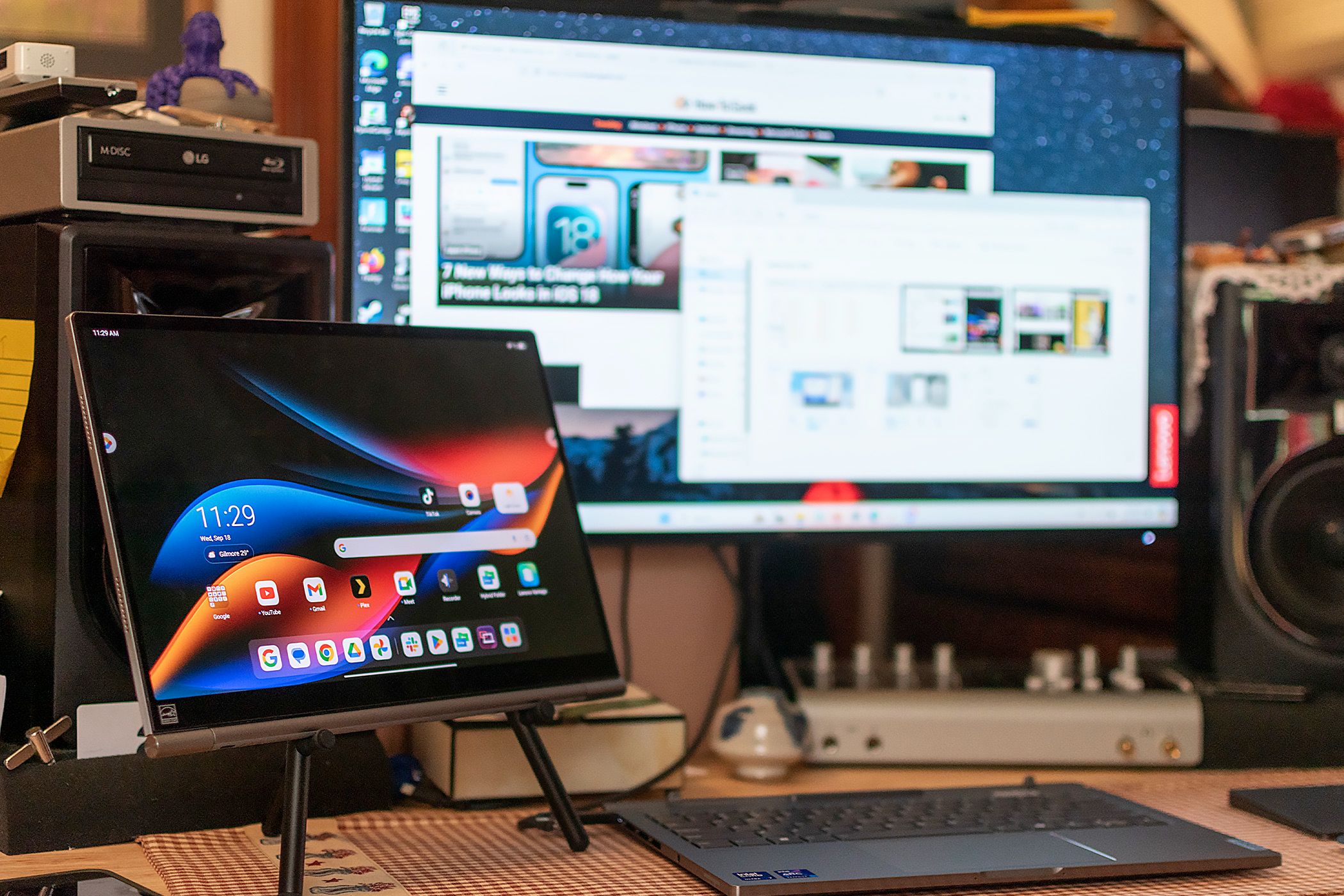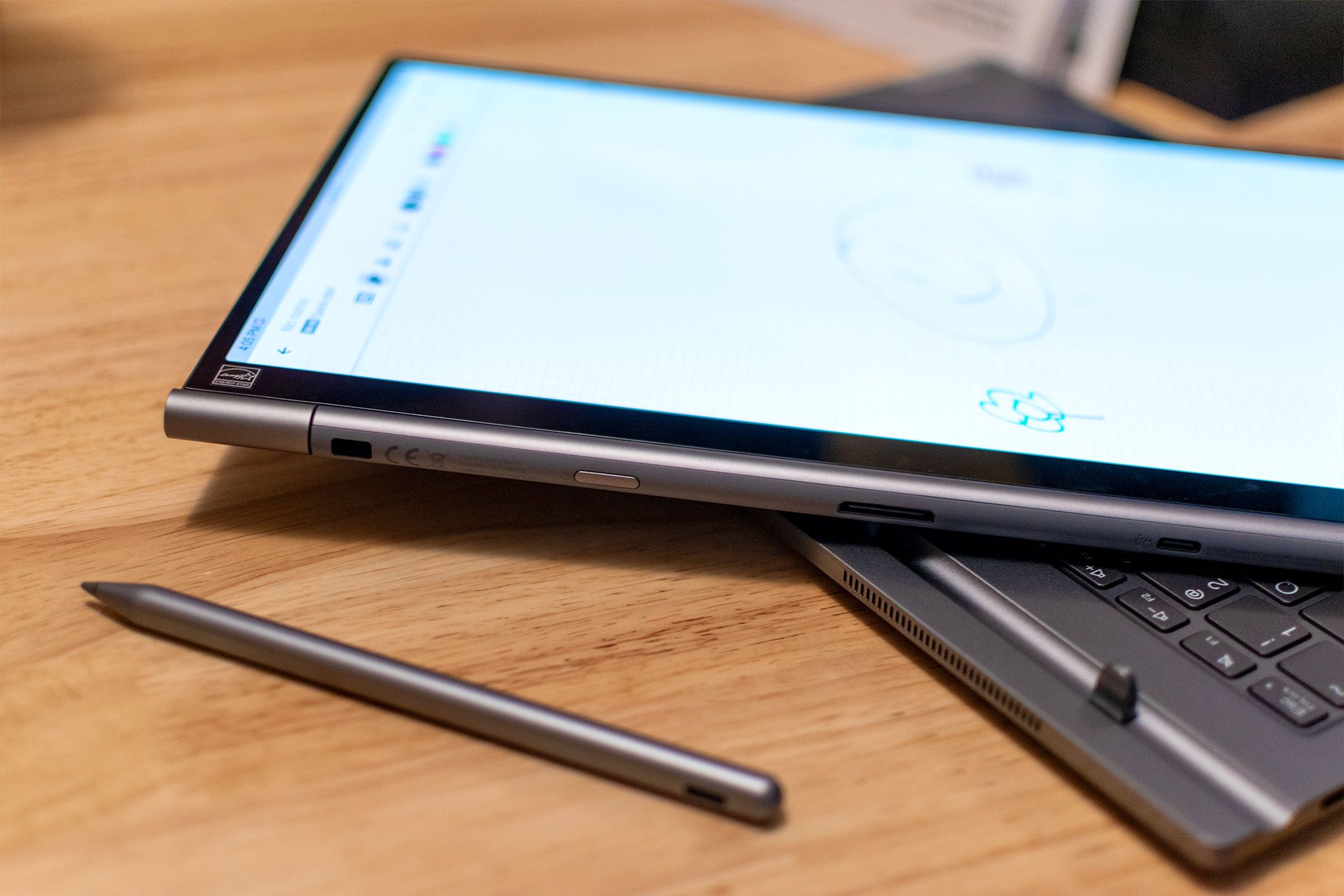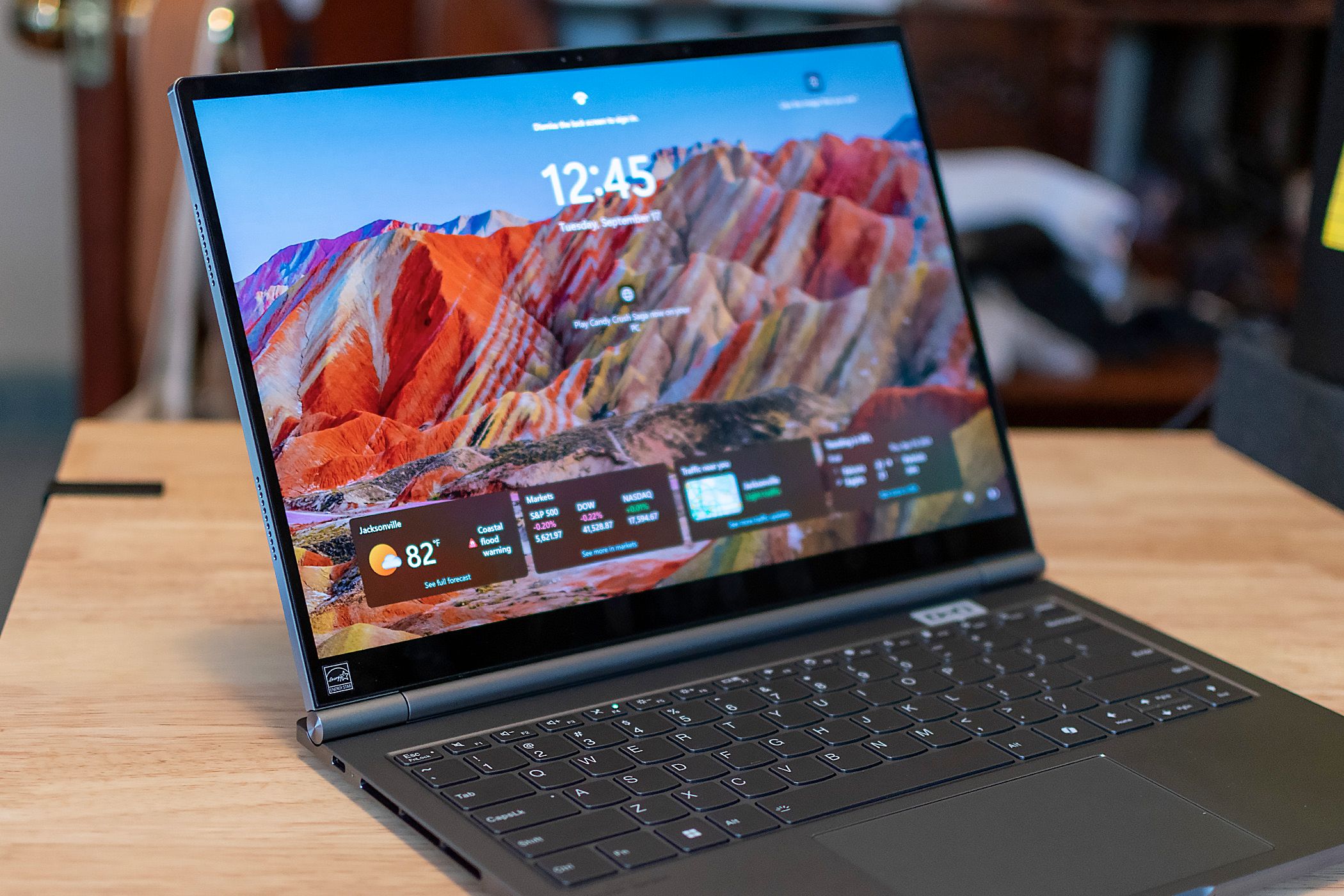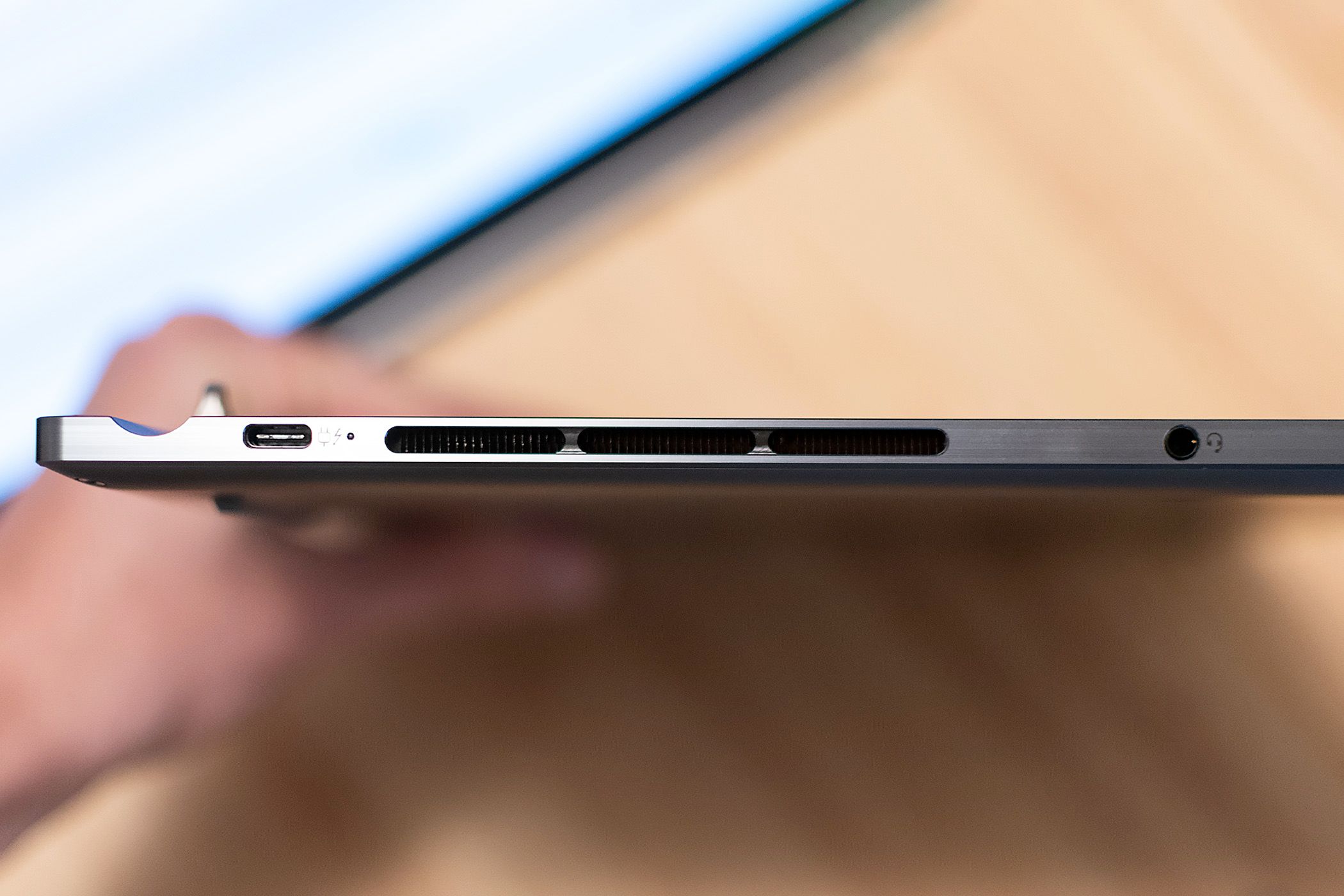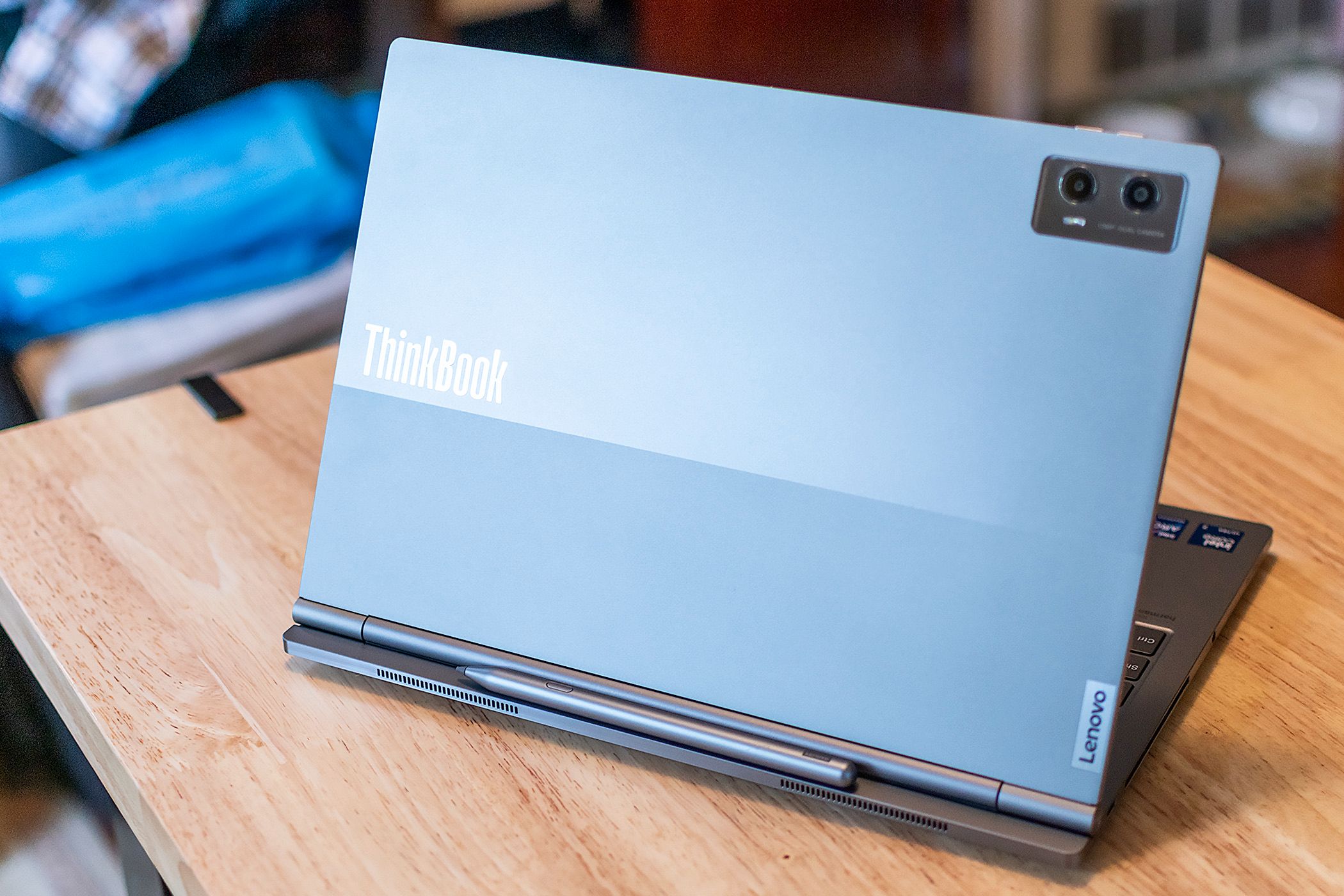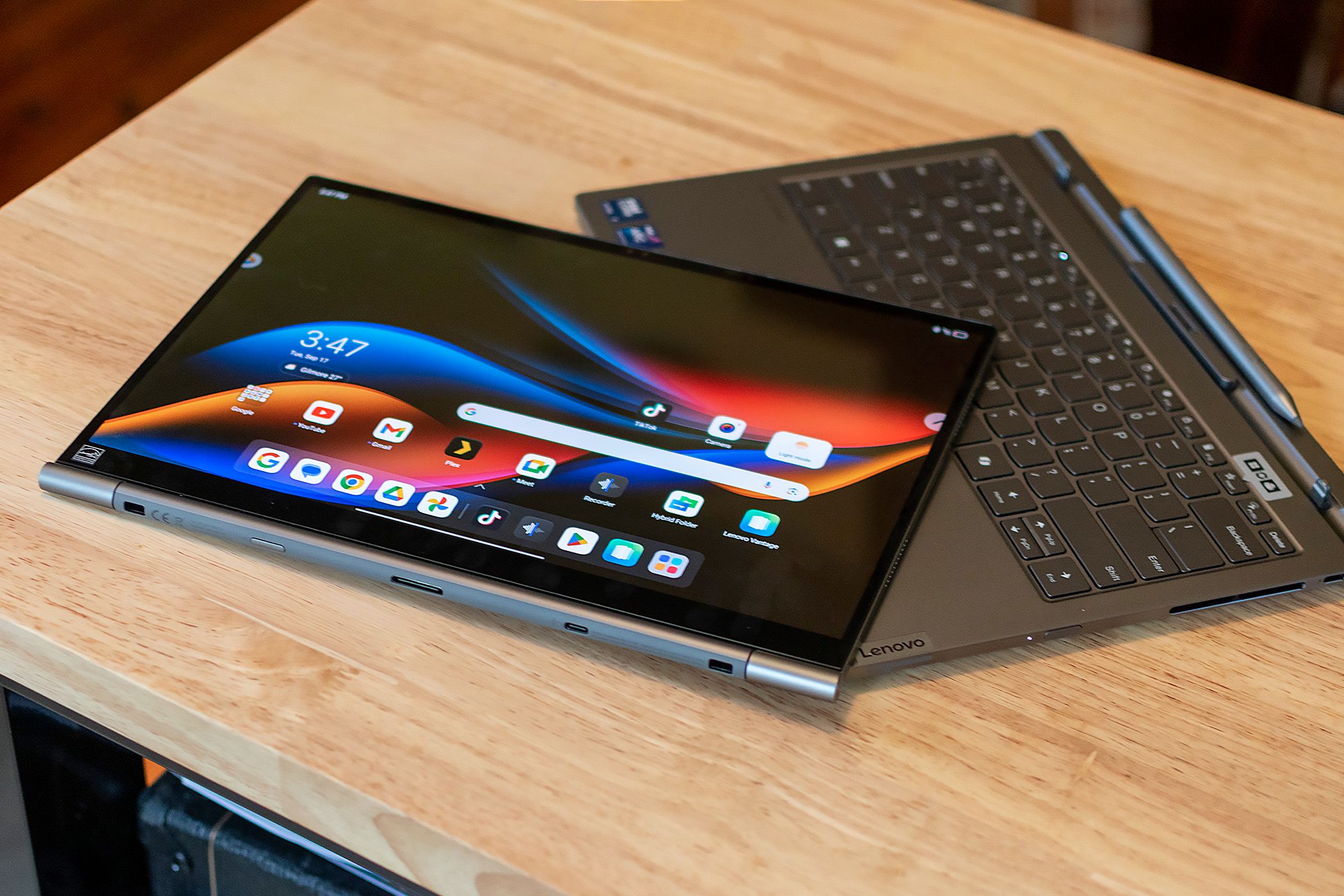
Key Takeaways
- Lenovo’s ThinkBook Plus Gen 5 Hybrid is the only two-in-one Windows and Android tablet available today.
- The hardware, specs, and display are all flagship-level, though the port selection leaves a lot to be desired.
- At $3,518, the ThinkBook Plus Gen 5 Hybrid is plainly overpriced.
A Windows laptop that doubles as an Android tablet. That’s the idea behind Lenovo’s ThinkBook Plus Gen 5 Hybrid, an odd machine that’s left me mystified. It’s a unique piece of engineering, a questionable concept, and a massive investment all wrapped up in a 14-inch machine.
Lenovo ThinkBook Plus Gen 5 Hybrid
Lenovo’s ThinkBook Plus Gen 5 Hybrid offers a combined Windows and Android experience, flagship power, and a gorgeous screen. It may be worth buying if you can look past the price tag and find a good use for the Windows-Android hybrid technology.
- The first and only Windows-Android 2-in-1 laptop
- Gorgeous 14-inch 2.8K OLED display
- Flagship specs
- Stylus, tablet stand, and 100-watt charger are included
- Crazy expensive
- It’s hard to detach the screen from the keyboard
- No headphone jack in tablet mode
- Feels like a solution in search of a problem
Pricing and Availability
You can order the ThinkBook Plus Gen 5 Hybrid today at the Lenovo web store. However, the hybrid laptop is only available in a $3,518 configuration.
Snapdragon up Top, Intel Down Below
It’s hard to explain the concept behind Lenovo’s ThinkBook Plus Gen 5 Hybrid laptop. This machine is truly the first of its kind, and as a result, it goes against a lot of the conventions established by Microsoft’s Surface tablets, Yoga laptops, and other Windows two-in-ones. You might say, “well, duh, it can run Android,” but it’s a bit more complicated than that.
Let’s start with the basics. The ThinkBook Plus Gen 5 Hybrid is literally two separate machines. The display contains all the inner workings of a high-end Android tablet, including a Snapdragon 8+ Gen 1 chipset, while the keyboard is a fully baked “Copilot+ PC” with a 15th-gen Intel Core Ultra CPU.
You can switch between the Windows and Android operating systems at any time by pressing a button in the laptop’s function row. However, this dual-OS system only works when the laptop is in laptop mode. When detached, the display can only load Android, and the keyboard (which you may plug into an external monitor) is stuck with Windows.
There are some benefits to this symbiotic system. While the ThinkBook Plus Gen 5 Hybrid is a bit heavier than I’d like (about four pounds in its standard configuration if we ignore the hefty 100-watt power brick), it takes up slightly less space than the typical laptop and tablet. You could take this device to work, plug the keyboard into your monitor, set the screen-turned-Android-tablet to your side, and enjoy a dual-device experience that’s streamlined by specialized file-syncing software. (A folding tablet stand is included with the laptop for this specific use case.)
The ThinkBook Plus Gen 5 Hybrid may also be good for travel, as it’s one of the few 14-inch Android tablets that can actually be considered “space-saving.” And because there are two batteries in this device—one for the Android stuff and another for Windows—you may be compelled to use Android when in laptop mode. I frequently jumped into Android when procrastinating at work, as doing so noticeably improved my battery life in Windows.
Of course, these challenges could be overcome without a hybrid device. You could just buy a laptop and a tablet, or a laptop and an external monitor, or a laptop and a USB power bank. The sales pitch, when you really get down to it, is that the ThinkBook Plus Gen 5 Hybrid is a Windows laptop with a screen that doubles as an Android tablet. And that’s about it.
Uh, How the Heck Do You Use This Thing?
Like any $3,518 laptop, the ThinkBook Plus Gen 5 Hybrid feels fancy, sturdy, bright, and beautiful. It’s a neat machine with minimal plastic and maximum metal—a great example of great build quality. And, because this is a high-end Lenovo product, the keyboard and trackpad are totally up to snuff.
Still, the hybrid laptop’s defining feature—a detachable screen that turns into an Android tablet—is a bit of a puzzle. It took me a while to figure out how to attach the screen to the laptop. If you don’t put it on just right, the screen sits slightly akimbo and won’t close all the way.
The ThinkBook Plus Gen 5 Hybrid’s screen can only be attached or detached at a 90-degree angle. That’s what the instructions say. And, yes, the instructions are correct. It’s just a weirdly precise, somewhat ungraceful process that still makes me feel awkward after three weeks of testing.
Removing the laptop’s screen is a particularly brutal challenge—there’s no button or latch; you just tug at the screen while holding the keyboard in place with your non-dominant hand. I inevitably press a few buttons on the keyboard or touchscreen every time I try to go into tablet mode, and when the screen finally pops out of place, I feel like a kid who’s just done something wrong.
I hate to start a review with a complaint. But the whole idea behind the ThinkBook Plus Gen 5 Hybrid is that it is both a Windows laptop and an Android tablet, a literal two-in-one. Professionals like me can bring this machine to work, plug the bottom half into a computer monitor, set the display on a stand, and enjoy a PC-plus-tablet experience with seamless file sharing and such. The process of detaching the laptop’s display should be far more graceful and satisfying, as it’s a core part of using this laptop.
To Lenovo’s credit, the mechanism that holds this laptop’s screen in place is very rigid. The screen doesn’t bob or bounce around when you’re in laptop mode. In fact, it stays in place better than most laptop touchscreens, which is not what I expected.
Don’t Overlook the Software
Microsoft-made tools like Phone Link have morphed Windows into a decent companion for Android. That said, Microsoft’s Windows-to-Android software is primarily intended for smartphones, not tablets, and the ThinkBook Plus Gen 5 Hybrid is an odd breed with a unique set of needs.
So, Lenovo designed a Windows-to-Android stack that provides a more seamless experience than the standard Phone Link system. If you open up File Explorer, you’ll find that the Android OS’ filesystem can be accessed from Windows. There’s also a shared “Hybrid Folder” that both devices can dip into at any time, and photos taken on the Android tablet can be automatically synced to the Windows gallery.
There’s even a Hybrid Stream tool that brings the Android operating system onto the Windows desktop. Hybrid Stream is great for watching TikTok while in laptop mode, although it doesn’t support wireless streaming, which seems like a missed opportunity.
These unique software solutions are tucked within the HybridCenter app. They’re also presented to you through a series of popups after you set up the ThinkBook Plus Gen 5 Hybrid. And, importantly, Lenovo’s software doesn’t impede on normal Phone Link functionality, so you can still connect your smartphone to the laptop.
However, I’m concerned about long-term software support. There’s a lot of specialized software on here that may need to be adapted for future Windows and Android updates. Sales figures often dictate the level of software support that a product may receive, and I don’t see this thing flying off of store shelves, so the future of the ThinkBook Plus Gen 5 Hybrid is a mystery.
A Beautiful Screen and a Decent Stylus
There’s nothing better than a big, beautiful screen. The ThinkBook Plus Gen 5 Hybrid boasts a 14-inch, 2.8K resolution OLED panel—touchscreen, of course—with a 60Hz refresh rate and an anti-reflection coating. It’s a pleasure to use something that looks this nice, although the 14-inch size is a bit cumbersome when in tablet mode.
Some people may be disappointed to see a 60Hz refresh rate in such an expensive machine, but this is a business laptop, so 60Hz is fine by me. My only complaint about the display is its default color profile. While I’m sure that some customers will enjoy the vivid colors that you get out of the box, I prefer more accurate, less exaggerated colors. Adjusting the colors in Android took all but a few seconds (I changed the display profile from “Vivid” to “Standard”), but I couldn’t bring myself to deal with the Intel Graphics Command Center in Windows.
Lenovo also includes a Tab Pen Plus stylus with the ThinkBook Plus Gen 5 Hybrid. While it’s far from the “best” stylus in Lenovo’s portfolio (we’re talking about a company that sells 25 different styluses) the Tab Pen Plus is a nice piece of kit. It offers 4,096 levels of pressure detection, tilt detection, palm rejection, and Bluetooth fast pairing. I rarely used the stylus to write notes, but I regularly reached for it when adjusting window sizes, as it provided a sense of accuracy that I can never seem to get from Windows trackpads.
Other reviewers say that the Tab Pen Plus cannot magnetically attach to the ThinkBook Plus Gen 5 Hybrid. I’m not sure what they’re talking about, as there are several magnetic attachment points on this device—two on either side of the trackpad, one at the base of the screen, another at the rear of the laptop chassis, and two on the backside of the tablet. However, wireless charging is not supported, so you need to plug a USB-C port into the stylus every now and then.
Flagship Performance for a Business Laptop
As I’ve mentioned throughout this review, the ThinkBook Plus Gen 5 Hybrid is a high-end Windows laptop and a high-end Android tablet. The spec sheet is a total whos-who of hardware, with fancy components in both the detachable display and keyboard base station.
The Windows side of things is powered by a 15th Gen Intel Core Ultra 7 processor, 32GB of LPDDRX5 RAM, and 1TB of PCIe Gen 4 storage. So, it’s a “Copilot+ AI PC,” and Windows 11 performance is quite good. I didn’t experience any hiccups or slowdowns during my three weeks with the machine, although the lack of a dedicated GPU proved to be a limiting factor when gaming. Integrated Intel Arc graphics are surprisingly good—I pushed Fortnite pretty hard before hitting a bottleneck—but this is a business machine at its core. It also puts out a lot of heat, and its fans get pretty noisy, but uncomfortable thermals are part and parcel for a slim laptop with a desktop-class Intel CPU.
Android functionality is delivered by a powerful Qualcomm Snapdragon 8+ Gen 1 chipset with 12GB of LPDDR5X RAM and 256GB of UFX 3.1 storage. Any Android tablet with these specs is a winner, at least in terms of raw horsepower. The flagship Snapdragon chipset is overkill for those who just want to stream video or take notes, but it’s a good option for Android gaming and it ensures a long lifespan for the tablet.
On the subject of future-proofing, this device ships with Android 13 and can update to Android 14. It’s effectively one year behind the current Android version. This isn’t unusual for Android tablets, but it’s something that I hate to see in a product with flagship specs.
A Disappointing Port Selection
Business laptops tend to have a lot of ports. Unfortunately, the ThinkBook Plus Gen 5 Hybrid is barren. You get two Type-C Thunderbolt 4 ports (40Gbps) and a headphone jack in the laptop body, plus a single USB-C 3.0 port in the tablet—this extra USB port is only available in tablet mode, as it’s inaccessible when the screen is attached to the laptop body.
I really would’ve appreciated an HDMI jack, a USB-A port, and an SD card slot. But the thing that really disappoints me is the absence of a headphone jack on the tablet. This is something that impedes my ability to have a seamless Windows-to-Android experience—I can use my wired headphones in laptop mode, but I need to grab a USB-C dongle (or wireless earbuds) if I want to switch over to tablet mode.
Thankfully, Lenovo didn’t skimp on wireless connectivity. Both the laptop and tablet portions of the ThinkBook Plus Gen 5 Hybrid support Bluetooth 5.3 and Wi-Fi 6E. Though I’d like to reiterate that the ThinkBook Plus Gen 5 Hybrid is two devices in one. A Bluetooth connection made with Windows 11 won’t carry over to Android, and so on. Even if your earbuds or headphones support multipoint pairing, you’ll probably be frustrated by this particular quirk.
Should You Buy the Lenovo ThinkBook Plus Gen 5 Hybrid?
I’ve spent three weeks with the Lenovo ThinkBook Plus Gen 5 Hybrid. Still, I can’t figure out who this machine is meant for. There are certainly some benefits to Lenovo’s hybrid Windows-Android design, but at the end of the day, I’d rather have a normal laptop and tablet. Or, at the very least, a Windows two-in-one that’s always in Windows mode.
Pricing is also a problem. When we first encountered the ThinkBook Plus Gen 5 Hybrid at CES 2024, Lenovo said that it would start at $2,000. Now, at launch, it costs $3,518. It’s worth more than the equipment that I use to make my livelihood as a professional writer. It’s worth more than my American-made guitars and boutique amplifiers. Hell, it exceeds the Blue Book value of my car! Spending $3,518 on what is essentially an engineering magic trick, especially one without an NVIDIA or AMD GPU, is something that I really struggle to understand.
For comparison’s sake, an ASUS ROG Zephyrus laptop with a 16-inch 240Hz display, 15th Gen Intel Core Ultra 9 CPU, and RTX 4080 GPU carries an MSRP of $2,699. I could spring for a top-of-the-line ASUS gaming laptop and buy a high-end Android tablet (or iPad, preferably) for less than the price of the ThinkBook Plus Gen 5 Hybrid that I’m reviewing today.
I’m sure that there are people who will buy and love the ThinkBook Plus Gen 5 Hybrid. It’s a good machine with a neat gimmick. Unfortunately, I’m not sold on the concept, I can’t endorse the price, and I’m worried about long-term software support.
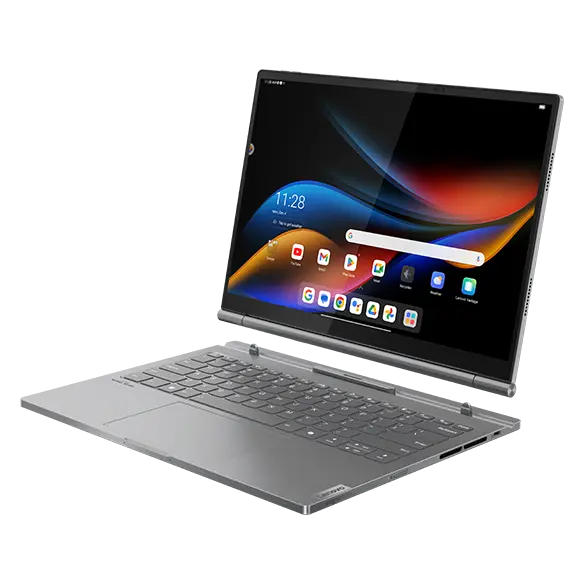
Lenovo ThinkBook Plus Gen 5 Hybrid
Lenovo’s ThinkBook Plus Gen 5 Hybrid offers a combined Windows and Android experience, flagship power, and a gorgeous screen. It may be worth buying if you can look past the price tag and find a good use for the Windows-Android hybrid technology.
Source link


